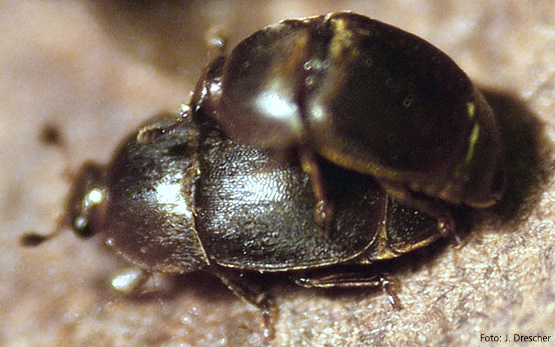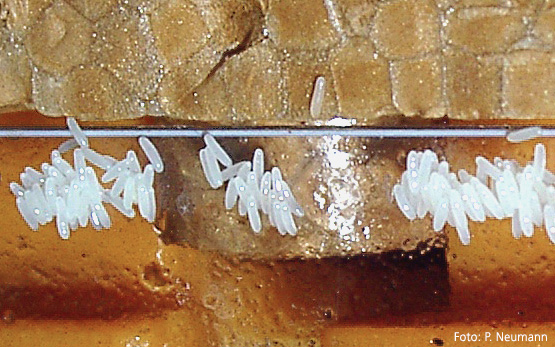The small hive beetle, Aethina tumida, is a parasite and scavenger of social bee colonies, which is native to regions of Africa that are South of the Sahara. It has become an invasive species and has been recorded in a number of countries outside its natural range since 1996. In the USA and Australia, it has managed to establish populations and can cause considerable damage to local honeybee, Apis mellifera, colonies. It is now established since 2014 in South of Italy. In contrast to V. destructor, the small hive beetle is not only dependent honey bee colonies for his survival. He can feed and reproduce on fruits for example. In the hive beetles consume honey, pollen and brood. The females lay their eggs in areas out of reach of honey bee mandibles. It is the larvae emerging from these eggs that damage the colonies. They contaminate the honey with bacteria and fungi they carry, which results in a fermentation process. Before pupation, the larvae leave the hive and burry themselves in the ground. Their further development depends on soil quality and temperature. The adults emerging from their pupation chambers take flight and search for food sources (fruits or honey bee colony) as well as for a mate. More details on the lifecycle of the small hive beetle are to be found in the brochure published by the European Reference Laboratory and on the website of the Honey bee Health Service.

Small hive beetles mate in the hive. During mating, the slightly smaller males rides the female for a long periods (Photo: J. Drescher)

After mating, female beetles typically lay egg clutches hidden in cracks or directly on combs. Beetle eggs are about 2/3 the size of honey bee eggs (Photo: P. Neumann).

Hatching larvae are the most destructive life stage in honey bee colonies. Even relatively strong colonies can be totally destroyed from heavy larval infestations (Photo: M. Schäfer).

After the feeding stage, which can last between 8-29 days, the post feeding wandering larvae leave the colony to pupate in suitable surrounding soil. It leaves a trail of feces and fermented bee products. Wandering larvae have a length of 10-12 mm (Photo: M. Schäfer).

A small hive beetle pupa within a pupation chamber. Depending on soil type, wandering larvae excavate pupation chambers from 5-10 cm beneath the soil surface (Photo: A. Röttger)

Pupation can last between 3 weeks and 3 months depending on environmental conditions (soil humidity and temperature). After pupation, emerging adult beetles leave the soil and disperse over considerable distances to find new host colonies or other food sources and start the life cycle again (Photo: A. Röttger)





